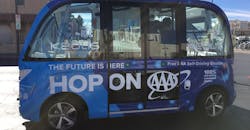Using low-speed shuttles to introduce automated vehicles to the public
Low-speed shuttles are a popular way for cities to introduce automated vehicle technologies to the public, and could lead to more autonomous freight deliveries in urban areas, according to the U.S. Department of Transportation’s Volpe Center.
These shuttles usually hold up to 15 passengers, have a top speed of no more than 25 mph, and cruise at about 10 mph.
Volpe Center said in a report there have been about 260 low-speed automated shuttle demonstrations and pilot programs across the globe as of August, including some freight-specific projects.
About two-thirds of the projects in the United States have been announced since the start of 2017, "indicating growing domestic awareness of these vehicles and interest in deploying them,” Volpe said.
In the short term, these pilots are used to gather data, spur economic development, and expose the public to the technology.
"For many people, early-stage low-speed automated shuttle deployments will be their first time encountering automated driving technologies. This first exposure is important, because it may influence broader public acceptance of vehicle automation,” the report said.
An example is Las Vegas, which last year launched a free, automated shuttle to provide service around a loop in the city’s downtown.
The one-year pilot is operating on a public street with mixed-flow traffic and high pedestrian activity. The route uses vehicle-to-infrastructure communications to provide the shuttles with information at traffic lights.
These demonstrations "are widely seen among deployment communities as an early step in the process of using automation to address transportation challenges,” Volpe said.
Among those challenges are first- and last-mile connectivity. While low-speed automated shuttles may not currently be capable of fully delivering on these desired benefits, it could help spur advancements in urban deliveries.
For example, these shuttles could deliver groceries and other retail items from stores and warehouses to various addresses in a defined area.
Additionally, deliveries with similar origins and destinations can be combined on the same shuttle, and could utilize delivery robots to carry items to a recipient’s front door, Volpe's report said.
About the Author
Neil Abt
Neil Abt is a former FleetOwner editor who wrote for the publication from 2017 to 2020. He was editorial director from 2018 to 2020.
